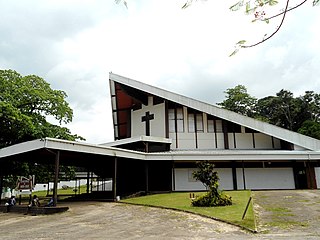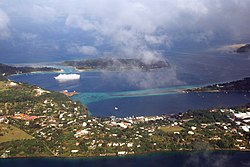
Vanuatu, officially the Republic of Vanuatu, is an island country in Melanesia located in the South Pacific Ocean. The archipelago, which is of volcanic origin, is 1,750 km (1,090 mi) east of northern Australia 540 km (340 mi) northeast of New Caledonia, east of New Guinea, southeast of Solomon Islands, and west of Fiji.

Vanuatu is a nation and group of islands in the South Pacific Ocean. It is composed of over 80 islands with 2,528 kilometres (1,571 mi) of coastline and a total surface area of 12,189 square kilometres (4,706 sq mi). It's a small country with a total size of 12,189 km2 (4,706 sq mi). Due to the spread out islands it has the 39th largest Exclusive Economic Zone of 663,251 km2 (256,083 sq mi).

Bauerfield International Airport is an airport located in Port Vila, Vanuatu. The airport is relatively small in size, but its runway has the capability and length to accept jets up to the Airbus A330. It served as the hub for Vanuatu's flag carrier airline, Air Vanuatu.

Efate is an island in the Pacific Ocean which is part of the Shefa Province in Vanuatu. It is also known as Île Vate.

Pentecost is one of the 83 islands that make up the South Pacific nation of Vanuatu.

Shefa is one of the six provinces of Vanuatu, located in the center of the country and including the islands of Epi and Efate and the Shepherd Islands. The province's name is derived from the initial letters of SHepherd and EFAte. It has a population of 78,723 people and an area of 1,455 km2 (562 sq mi). Its capital is Port Vila, which is also the capital of the nation.

Ni-Vanuatu is a large group of closely related Melanesian ethnic groups native to the island country of Vanuatu. As such, ni-Vanuatu are a mixed ethnolinguistic group with a shared ethnogenesis that speak a multitude of languages.

Paama is a small island in Malampa Province, Vanuatu.

The Roman Catholic Diocese of Port-Vila in Vanuatu is a suffragan diocese of the Roman Catholic Archdiocese of Nouméa.

Iririki is a privately owned island resort located in Mele Bay, Port Vila, the Capital of Vanuatu.

Severe Tropical Cyclone Ivy was a tropical cyclone that affected about 25% of the population of Vanuatu in February 2004. It was first classified as a tropical disturbance on February 21 between Vanuatu and Fiji. The system tracked northwestward, gradually organizing and intensifying. After attaining tropical storm status on February 23, Ivy strengthened more quickly as it turned southwestward toward Vanuatu. It attained peak winds of 165 km/h (103 mph) while moving over Vanuatu, making it an intense Category 4 cyclone on the Australian Region Tropical Cyclone Intensity Scale. By the time it passed through Vanuatu, Ivy had turned southeastward, and it gradually weakened while accelerating. After becoming extratropical on February 28, it passed just east of New Zealand and eventually dissipated on March 2.

The Vanuatu Labour Party is a political party in Vanuatu. The party was established on 3 June 1987. It was founded on the initiative of various trade union organizations in order to contest the 1987 parliamentary election. The proposal to found the party was first presented by Ephraim Kalsakau, a leader of the Vanuatu Municipal Workers Union.

Severe Tropical Cyclone Pam was the second most intense tropical cyclone of the South Pacific Ocean in terms of sustained winds and is regarded as one of the worst natural disasters in the history of Vanuatu. A total of 15–16 people died either directly or indirectly as a result of Pam with many others injured. The storm's impacts were also felt, albeit to a lesser extent, on other islands in the South Pacific, most notably the Solomon Islands, Tuvalu, and New Zealand. Pam is the third most intense storm of the South Pacific Ocean according to pressure, after Winston of 2016 and Zoe of 2002. It is also the second most intense tropical cyclone in 2015, only behind Hurricane Patricia. In addition, Pam is tied with Orson, Monica, Marcus and Fantala for having the second strongest ten-minute maximum sustained winds in the Southern Hemisphere. Thousands of homes, schools and buildings were damaged or destroyed, with an estimated 3,300 people displaced as a result.
Mele-Fila (Ifira-Mele) is a Polynesian language spoken in Mele and Ifira on the island of Efate in Vanuatu. In spite of their differences, Mele and Fila are two dialects of the same language and are mutually intelligible. French and English are also fairly common among the residents of Efate.

Severe Tropical Cyclone Fran was the third tropical cyclone within four weeks to impact Vanuatu in 1992. Fran formed on 4 March and then gradually intensified, with winds reaching gale-force on 5 March, and hurricane-force a few days later. Few days later, Cyclone Fran reached severe tropical cyclone status near Vanuatu, and also became a powerful Category 5-equivalent on the Saffir–Simpson Hurricane Scale. The storm weakened somewhat due to land interaction, but briefly re-intensified after moving away from land. Fran gradually weakened over the next several days over less favorable conditions. Meanwhile, the storm passed north of New Caledonia. Eventually, as a Category 2 system on the Australian scale, Fran made landfall on Queensland on 16 March. Afterwards, Cyclone Fran turned towards the southeast and eventually headed back out to sea, eventually dissipating the next day. On Efate, over 130 houses lost roofs. Along Queensland, two rivers sustained major flooding, but no deaths were attributed to this cyclone. Total damage from the system was AU$8–10 million. Moderate damage was also reported in Fiji. In New Caledonia, the storm brought flooding and landslides.

Mavia or Mavea is an inhabited island in Sanma Province of Vanuatu in the Pacific Ocean. The island lies off the eastern coast of Espiritu Santo. The estimated terrain elevation above the sea level is some 63 metres.

Squatting in the Republic of Vanuatu is the occupation of unused land or derelict buildings without the permission of the owner. After independence in 1980, informal settlements developed in cities such as Luganville and the capital Port Vila. Land in Vanuatu is either custom land owned by indigenous peoples or public land owned by the republic.

The 2002 Port Vila earthquake occurred in the early dawn of 3 January 2002, 4:22 a.m. local time (UTC+11) northwest of Port Vila, the capital of Vanuatu. It had a magnitude of 7.2 and a maximum intensity of X (Extreme) west of the island on the Modified Mercalli intensity scale. There are no exact estimates on the number of injured individuals, but the majority of accounts say there were "several" amounts of injured civilians. the event also caused a minor tsunami of about 0.4–0.8 m just 11 minutes after the quake.

At 12:47:26 VUT on 17 December 2024, a 7.3 earthquake struck near Port Vila, the capital of Vanuatu. At least 14 people died while 265 others were injured. Extensive damage occurred in Port Vila and surrounding areas. The earthquake also generated a 25 cm (10 in) tsunami.

Snap general elections were held in Vanuatu on 16 January 2025, having been moved from 14 January 2025 due to the 2024 Port Vila earthquake on 17 December.



































